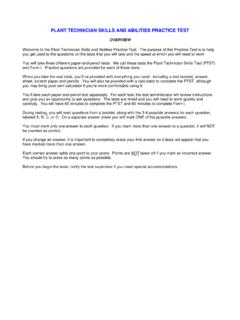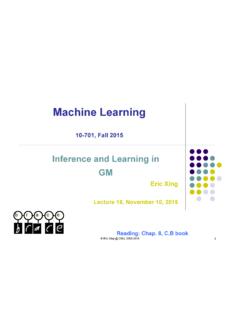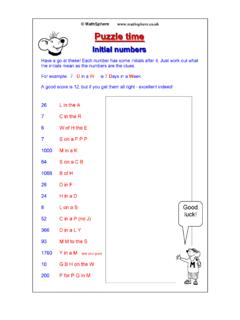Transcription of Edexcel GCSE Mathematics (1387) Higher Tier 2003 …
1 Edexcel gcse Mathematics (1387). Higher Tier 2003. Model answers In general, the number of significant figures in an answer should not exceed the number of significant figures in the input data, or if this data has differing numbers of significant figures, the data with the lowest number of significant figures. Brian Daugherty Statements in italics are for information rather than a part of the answer Paper 5 (Non-Calculator), 4 June 2003. Question 1 Question 5. (i) Constant first difference of 5 the required expression is of the form 5n + k (ii).
2 Where k is a constant 119 310 On inspection k = 1. So expression is (iii). 5n + 1. Question 6. Question 2. (a) D has vertices 10% of 12000 = 1200 (0, 0), (3, 0), (0, 2). Therefore value of car after 1 year (b) rotation by 180 (anti-clockwise or clockwise) about = 12000 1200 = 10800 (0,1). Now 10% of 10800 = 1080. Question 7. Therefore value of car after 2 years Draw bisector of BC through A. = 10800 1080 = 9720. Draw an arc of 5cm from A (using compasses). Shaded area will be 'above' bisector and to the 'left' of arc. Question 3. 7r + 2 = 5(r 4) Question 8.
3 7r + 2 = 5r 20. 2r = 22 x + y + z : Length r = 11 xyz : V olume xy + yz + xz : Area Question 4. (a). Question 9. 1, 0, 1. (a) A 'short' question could be on the lines : list, in order, (b) Insert lines corresponding to your three favourite genres of food you like to eat in x = 2 a restaurant? (any attempt to include all possibilities x=1 and not 'lead' the respondents on will be satisfactory. y = 2. y =x+1 (b) 1. His family is not representative of the population as a whole giving the required points, as follows 2. The question is directing the respondents to a par- (1, 1), (1, 0), (1, 1), (0, 0), (0, 1), ( 1, 1) ticular answer 1.)
4 2. Question 10 Question 15. (a) Distance travelled 40. 4 2. 40 = 2 radians = 8 10 6 10 360. Length of arc = 48 106 40. =9 2 = 2 . 7. = 10 km 360. So total perimeter (b). = (18 + 2 ) cm (2 105 ) + (3 104 ). = (20 104 ) + (3 104 ) Question 16. = 23 104. (i). = 230 000km 40 = 1. (ii). Question 11. 1 1. (a) 4 2 = 2. =. 4 16. (x + y)2 (iii). = (x + y)(x + y) 3. 1 3. 16 2 = 16 2 = 43 = 64. = x2 + 2xy + y 2. (b) Expression can be stated as Question 17. ( + )2 (a). = 52 = 25 1. F . x2. k Question 12 F =. x2. (i) Angle ACB = 27 , because FE is a tangent to the circle, When x=3, F=4.
5 And therefore angle ACE = 90 . k 4= k = 36.. (ii) Angle BAC = 63 , because (1) the diameter AC sub- 9. tends an angle of 90 at the circumference and (2) from so 36. (i) we know that angle ACB is 27 . F =. x2. (b). Question 13. 36. (i) F = =9. 4. (p3 )3 = p9 (c). 36 36 6 3. (ii) 64 = 2. x2 = x= =. x 64 8 4. 3q 4 2q 5 6q 9. = = 6q 6. q3 q3 Question 18.. Question 14 5+ 3 5 3.. (a) (i) lower quartile = 152 22. (ii) upper quartile = 177 25 3. = . 22. (b) Box plot consisting of left hand side of box at 152 and 22. right-hand side at 177.
6 A line representing the median = . is drawn at 167. Lines are extended to display the range 22.. - to the left to 132 and to the right to 182. = 22. 3.. Question 19 =3. 5.. 5.. 5. 10 10 10. 10 x 25 60. (a). 25 x 30 40 125 375. =3 =. 1000 1000. (b) Between 30 and 40, units high P(2 green). Between 40 and 70, 10 units high = P (G, G, N G) + P (G, N G, G) + P (N G, G, G). Question 20 . 2 2 8. (a) =3 . 10 10 10. 2(3x + 4) 3(4x 5). 32 96. =3 =. = 6x + 8 12x + 15 1000 1000. = 6x + 23 So total probability (b) 189 375 96. = + +. 5 1000 1000 1000.
7 2xy 3. 660. = 25 x5 y 15 =. 1000. = 32x5 y 15. (c) Question 23. n2 1 2 (a) (i).. n+1 n 2. ~ = 6b 6a = 6(b a). AB. (n 1)(n + 1) 2. = . n+1 n 2 (ii). (n 1) 2. = . 1 n 2 ~ = 6a EF. 2(n 1). = (b). (n 2). ~ = 2 6b = 12b EB. Question 21. Multiply all coordinates by , so that apexes transform so ~ = 6a BC. (2, 1) ( 3, ) so ~ = 12b + 1 ( 6a) = 12b 3a EX. (2, 3) ( 3, ) 2. (3, 1) ( , ). (c). Question 22 ~ = 2 6(b a) = 4(b a). BY. 3. P(2 black). ~ = 12b + 4(b a). EY. = P (B, B, N B) + P (B, N B, B) + P (N B, B, B). = 12b + 4b 4a 3 3 7. =3 . 10 10 10.
8 = 16b 4a 63 189. =3 =. 1000 1000 4. = (12b 3a). P(2 red) 3. = P (R, R, N R) + P (R, N R, R) + P (N R, R, R) ~ and EY. so EX ~ lie along the same line 4. Question 24. (a) (i). (5, 4). (ii). (2, 9). (iii). (2, 4). (iv). (2, 4). (b) The general form of equation is y = ax2 + bx + c At (0,0). 0 = a(0)2 + b(0) + c c = 0. At (2,-4). 4 = a(2)2 + b(2) 4a + 2b = 4 (1). By symmetry, also crosses x-axis at (4,0), giving 0 = a(4)2 + b(4) 16a + 4b = 0 (2). 4 (1 ) - (2). 4b = 16 b = 4. and 4a + 2( 4) = 4. 4a = 4. a=1. so f (x) = x2 4x Paper 6 (Calculator), 10 June 2003.
9 Question 1 Question 4. (a) Volume of cylinder (a) Volume of cuboid = r2 h = (42 )(10) = x x (x + 1) = x3 + x2. = 160 = 503cm2 Therefore (b) Consider a right-angled triangle of sides 10 cm and 8 x3 + x2 = 230. cm 5 150 6 252. 2. Hypotenuse = 10 + 8 2 2 = 100 + 64 = 164 (b). Hypotenuse = So a pencil of 13cm cannot fit inside the cylinder So answer to 1 is Question 2. (a) (i) Question 5. 60 = 2 30 Area r2 = 22 15 = = = 2 2. = 22 3 5. (ii) Question 6. 96 = 2 48 (a). 2. = 2 24 1. 5= x+1. = 23 12 2. = 24 6. 1. x=4. = 25 3 2. (b) HCF x=8.
10 = 22 3 = 12. (b). (c) LCM. = 25 3 5 = 480 1. y= x+3. 2. Question 3 for example (any constant on the end will suffice). (a) Median = hald the 20th ans 21st items, which will fall (c). in the class 150 < C 200. 1. (b) One extra item at 1000 will raise the median to be y= x+1. 2. the 21st item, which lies in the same class as before (c) 1. x=y 1. 2. 100. 5200 = 6500 x = 2(y 1). 80. 5. 6. Question 7 Question 11. (a) For a fair dice, we would expect 100 sixes. 200 sixes is 2x 3y = 11 (3) too divergent a result, so dice is not fair. 5x + 2y = 18 (4) (b) Left-hand side of tree requires a probability of 5/6 o n (3) 2 the bottom branch.






